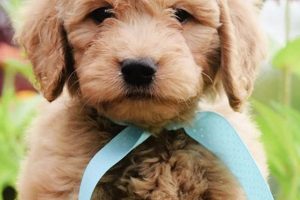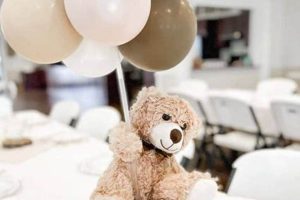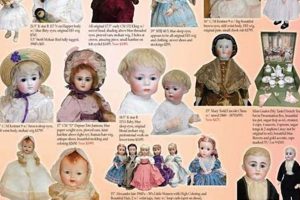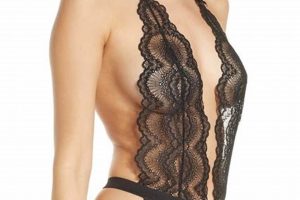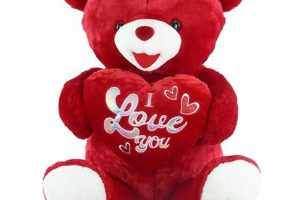Teddy bears manufactured during the 1980s represent a distinct era in the history of these beloved toys. This period saw the continued popularity of traditional designs alongside the emergence of innovative materials, manufacturing techniques, and character-licensed bears. Examples include bears from popular lines like Care Bears and Cabbage Patch Kids, as well as continued production from established companies like Steiff and Gund.
The decade offers collectors a fascinating range of options, reflecting the evolving trends in toy design and popular culture. These bears can hold significant sentimental value for those who grew up in the 1980s, representing a tangible link to their childhood. Furthermore, studying bears from this period provides insights into the manufacturing processes, marketing strategies, and societal influences prevalent at the time. The rise of licensed characters, for instance, reflects the increasing impact of media and entertainment on the toy industry.
Exploring this era of teddy bear production can offer a richer understanding of toy history, collecting practices, and the cultural significance of these enduring playthings. This discussion will further delve into specific manufacturers, popular styles, and factors contributing to the collectibility of 1980s teddy bears.
Tips for Collecting Teddy Bears from the 1980s
Acquiring teddy bears manufactured during the 1980s requires careful consideration and research. The following tips offer guidance for building a meaningful and valuable collection.
Tip 1: Identify Manufacturers: Research prominent manufacturers of the era, such as Gund, Steiff, and Knickerbocker. Understanding a manufacturer’s history and production methods contributes to assessing a bear’s authenticity and value.
Tip 2: Examine Materials and Construction: Bears from this period may feature synthetic plush, mohair, or other materials. Note stitching quality, joint types, and any unique features that distinguish specific manufacturers or lines.
Tip 3: Recognize Popular Styles: Familiarize oneself with popular styles of the 1980s, including character-licensed bears (e.g., Care Bears, Muppets), traditional designs, and limited-edition releases.
Tip 4: Assess Condition: Condition significantly impacts value. Look for signs of wear, repairs, or fading. Original tags and packaging can enhance a bear’s desirability.
Tip 5: Research Current Market Values: Utilize online resources, auction records, and collector guides to understand the prevailing market prices for comparable bears. This knowledge helps determine fair prices and avoid overpaying.
Tip 6: Verify Authenticity: Be wary of counterfeit bears. Examine labels, tags, and overall construction for inconsistencies that might suggest a reproduction. Consult with reputable dealers or experts when necessary.
Tip 7: Consider Storage and Preservation: Proper storage protects bears from damage. Avoid direct sunlight, extreme temperatures, and humid environments. Acid-free tissue paper can help prevent deterioration.
By considering these factors, collectors can make informed decisions and cultivate a collection of 1980s teddy bears that holds historical, sentimental, and potentially financial value. These insights should equip enthusiasts to navigate the market effectively and build a collection that aligns with their individual interests and goals.
This exploration into collecting 1980s teddy bears provides a foundation for further research and discovery. It encourages continued learning and engagement within the vibrant community of teddy bear enthusiasts.
1. Materials (plush, mohair)
Materials constitute a defining characteristic of vintage teddy bears from the 1980s, influencing their feel, durability, and overall aesthetic. An understanding of materials employed during this period provides crucial insights for collectors and enthusiasts.
- Plush Fabrics
Synthetic plush fabrics gained prominence in the 1980s, offering a softer, more affordable alternative to traditional materials. Variations in plush pile length and texture contribute to the diverse range of teddy bear styles from this decade. Plush allowed for vibrant colors and intricate designs, aligning with the trends of the era. Its widespread use reflects the shift towards mass production and affordability in the toy industry.
- Mohair
Mohair, a natural fiber derived from Angora goats, continued to be a prized material for high-quality teddy bears. Its distinctive sheen and luxurious feel distinguished mohair bears as premium items. Manufacturers like Steiff maintained their tradition of using mohair, appealing to collectors who valued traditional craftsmanship and heirloom-quality toys. Mohair’s continued presence signifies the enduring appeal of classic teddy bear designs.
- Synthetic Fillings
Polyester fiberfill became the standard filling material, replacing traditional materials like wood wool or kapok. This shift facilitated easier cleaning and maintenance, catering to the demands of modern lifestyles. The use of synthetic fillings also contributed to the lighter weight and greater flexibility of 1980s teddy bears.
- Construction Techniques
Manufacturing techniques evolved alongside material choices. Machine stitching became more prevalent, allowing for increased production efficiency. However, hand-stitching remained a hallmark of high-end manufacturers, emphasizing quality and craftsmanship. The interplay of these techniques reflects the diverse market segments catered to by teddy bear producers during the 1980s.
The materials employed in 1980s teddy bears reflect the evolving manufacturing landscape and consumer preferences of the decade. From the widespread adoption of synthetic plush to the continued use of traditional mohair, these material choices contribute significantly to the unique character and enduring appeal of vintage teddy bears from this era.
2. Manufacturers (Gund, Steiff)
Specific manufacturers played pivotal roles in shaping the landscape of vintage teddy bears during the 1980s. Understanding their contributions provides crucial context for collectors and enthusiasts. Examining companies like Gund and Steiff illuminates the diverse approaches to design, materials, and production that defined this era.
- Gund: Innovation and Mass Appeal
Gund, an established American manufacturer, embraced innovation and licensed characters during the 1980s. Their adoption of synthetic plush materials and mass-production techniques made teddy bears more accessible and affordable. Collaborations with popular properties like Sesame Street and Disney broadened their market reach, establishing Gund as a major force in the industry. This approach catered to evolving consumer preferences and the growing influence of media on toy design.
- Steiff: Tradition and Craftsmanship
Steiff, a renowned German manufacturer, maintained its commitment to traditional craftsmanship and high-quality materials. Their continued use of mohair and meticulous hand-stitching techniques positioned their bears as premium collectibles. Steiff’s adherence to established design principles appealed to collectors seeking heirloom-quality toys with historical significance. This dedication to quality and tradition solidified Steiff’s reputation as a producer of enduring and valuable teddy bears.
- The Rise of Licensed Characters
The 1980s witnessed a surge in the popularity of character-licensed teddy bears. Manufacturers secured licenses for popular characters from television shows, movies, and books, transforming beloved figures into tangible playthings. This trend reflected the increasing influence of media and entertainment on the toy industry, creating new avenues for collectors and broadening the appeal of teddy bears to a wider audience.
- Impact on Collectibility
The manufacturing practices and design choices of companies like Gund and Steiff directly influenced the collectibility of 1980s teddy bears. Limited edition releases, special variations, and character tie-ins contributed to a thriving secondary market. Factors like condition, rarity, and provenance played significant roles in determining a bear’s value. The interplay of these factors shaped the collecting landscape, providing enthusiasts with a diverse range of options and investment opportunities.
The contributions of manufacturers like Gund and Steiff, along with the rise of licensed characters, shaped the distinctive qualities of vintage teddy bears from the 1980s. Their diverse approaches to design, materials, and production created a dynamic market that continues to fascinate collectors and enthusiasts today. Examining their influence provides valuable insights into the evolution of the teddy bear and its enduring cultural significance.
3. Licensed Characters
The 1980s witnessed a significant shift in the teddy bear market with the rise of licensed character bears. This integration of popular figures from television, film, and books transformed the teddy bear landscape, impacting design, collectibility, and the cultural significance of these toys.
- Media Influence on Toy Design
The proliferation of licensed characters reflects the growing influence of media and entertainment on children’s toys. Teddy bears became a canvas for popular figures like the Muppets, Smurfs, and characters from Disney films. This trend transformed teddy bears from generic playthings into recognizable representations of beloved characters, expanding their appeal and creating new marketing opportunities.
- Impact on Collectibility
Licensed character bears introduced a new dimension to teddy bear collecting. The association with established franchises and popular characters created a distinct collecting niche. Limited edition releases, variations based on specific episodes or storylines, and character-specific accessories further fueled the demand. This led to an increase in the perceived value of certain bears, particularly those associated with highly popular characters or rare promotional tie-ins.
- Shifting Consumer Preferences
The popularity of licensed character bears reflects evolving consumer preferences during the 1980s. Children increasingly sought toys that embodied familiar characters from their favorite shows and movies. This demand drove manufacturers to secure licensing agreements and integrate these characters into their product lines. The shift towards character-driven toys reflects the broader cultural trend of media-driven consumerism.
- Expanding the Teddy Bear Market
The introduction of licensed characters broadened the appeal of teddy bears beyond traditional markets. Character tie-ins attracted new collectors and enthusiasts, drawing in fans of specific franchises. This expansion diversified the teddy bear market, leading to increased production, innovation in design, and a wider range of choices for consumers. This diversification contributed to the overall growth and evolution of the teddy bear industry during the decade.
The integration of licensed characters into the world of vintage teddy bears during the 1980s represents a pivotal shift in design, production, and consumer demand. This era demonstrates the increasing interplay between popular culture, media influence, and the enduring appeal of the teddy bear. The impact of licensed characters continues to resonate in the contemporary teddy bear market, influencing collecting trends and shaping the perceived value of vintage bears from this era.
4. Collectibility
Collectibility significantly contributes to the value and desirability of vintage teddy bears from the 1980s. Several factors influence a bear’s collectibility, including its condition, rarity, manufacturer, and association with popular culture. Bears in pristine condition, with original tags and packaging, command higher prices. Limited edition releases or those associated with specific events or historical periods also increase collectibility. For instance, a Steiff bear from a limited production run commemorating a historical event holds greater value compared to a mass-produced bear from the same period. The manufacturer’s reputation also contributes to collectibility, with established brands like Steiff and Gund holding a more substantial following among collectors. Furthermore, bears representing licensed characters from popular 1980s franchises like Care Bears or the Muppets often achieve heightened collectibility due to their nostalgic appeal and connection to broader cultural trends.
The condition of a vintage teddy bear plays a critical role in its collectibility. Bears exhibiting minimal wear and tear, retaining original features like eyes, noses, and fur, are deemed more desirable. The presence of original tags, labels, and packaging further enhances collectibility, offering evidence of authenticity and providing insights into the bear’s history. Conversely, significant damage, repairs, or missing components can detract from a bear’s value, even if it possesses other desirable characteristics. Therefore, collectors often prioritize well-preserved specimens, recognizing the impact of condition on long-term value and investment potential.
Understanding the factors that contribute to collectibility provides collectors with crucial knowledge for navigating the vintage teddy bear market. Recognizing the interplay between condition, rarity, manufacturer, and cultural significance enables informed purchasing decisions and facilitates the development of curated collections. Furthermore, this understanding allows collectors to appreciate the historical and cultural context surrounding these toys, recognizing their significance beyond mere playthings. The collectibility of 1980s teddy bears demonstrates the intersection of nostalgia, cultural memory, and market forces, contributing to their enduring appeal among collectors and enthusiasts.
5. Condition
Condition stands as a critical factor influencing the value and desirability of vintage teddy bears from the 1980s. Assessment requires careful examination of various aspects, impacting both a bear’s monetary worth and its historical significance. Understanding condition nuances allows collectors and enthusiasts to make informed decisions and appreciate the factors contributing to a bear’s preservation.
- Wear and Tear
Signs of wear, such as fraying fabric, thinning fur, or loose stitching, reflect a bear’s history and handling. While moderate wear can contribute to a bear’s character, excessive damage detracts from its value. A well-loved bear from the 1980s might exhibit flattened paw pads or minor seam separations, evidence of its role as a cherished childhood companion. Extensive wear, however, like large tears or significant fur loss, diminishes its appeal to collectors.
- Original Features
Retention of original features significantly impacts a bear’s condition assessment. Original eyes, noses, and mouths contribute to authenticity and historical accuracy. Replacements, particularly if not period-appropriate, diminish a bear’s value. A 1980s Care Bear with its original plastic eyes and felt nose intact holds higher value than one with later replacements. Maintaining these original features provides a direct connection to the bear’s manufacturing era.
- Cleanliness
Cleanliness contributes to a bear’s overall appearance and perceived value. Accumulated dust, dirt, or stains detract from its desirability. Proper cleaning methods, using appropriate materials and techniques, can improve a bear’s condition without causing further damage. A gently cleaned 1980s teddy bear with bright, unstained fur presents a more appealing image than one covered in dust or grime.
- Repairs and Restoration
Prior repairs, while sometimes necessary for preservation, can influence a bear’s value depending on the quality and extent of the work. Invisible repairs performed by skilled professionals often have minimal impact, while amateurish or extensive repairs can diminish desirability. A professionally re-stitched seam on a vintage bear is less concerning than a crudely patched tear. The nature of the repair and its impact on the bear’s overall appearance factor significantly into its assessment.
Careful evaluation of condition allows for a more comprehensive understanding of vintage teddy bears from the 1980s. Recognizing the various facets of conditionwear and tear, originality, cleanliness, and repairsprovides insights into a bear’s history, handling, and overall desirability. This awareness equips collectors with the knowledge necessary to appreciate the nuances of condition and make informed acquisitions that align with their collecting goals.
6. Value
Value, in the context of vintage teddy bears from the 1980s, encompasses a complex interplay of tangible and intangible factors. Monetary worth represents a significant component, influenced by market demand, rarity, and condition. However, sentimental value, historical significance, and the emotional connection associated with these objects also contribute substantially to their overall value. Understanding these multifaceted aspects provides a comprehensive perspective on the value attributed to these vintage toys.
- Market Value
Market value reflects the current price a willing buyer would pay for a specific teddy bear. Factors influencing market value include the bear’s manufacturer (e.g., Steiff, Gund), its condition, rarity, and provenance. A limited-edition Steiff bear in pristine condition with documented history commands a higher market value than a mass-produced bear with significant wear. Market trends, influenced by collector demand and economic conditions, also play a role in fluctuating valuations.
- Sentimental Value
Sentimental value represents the personal and emotional significance attached to a teddy bear. This intangible value often transcends monetary worth, reflecting cherished memories, childhood attachments, or inherited family heirlooms. A well-loved teddy bear from the 1980s, regardless of its market value, might hold immense sentimental value for its original owner, representing a tangible link to their past.
- Historical Significance
Certain vintage teddy bears hold historical significance due to their association with specific manufacturers, design trends, or cultural periods. Bears representing iconic designs, innovative manufacturing techniques, or reflecting popular culture trends of the 1980s contribute to historical understanding. For instance, a Cabbage Patch Kid bear from the 1980s reflects the unique cultural phenomenon surrounding these dolls and contributes to the broader narrative of toy history.
- Investment Potential
Certain vintage teddy bears demonstrate investment potential due to their rarity, historical significance, or increasing collector demand. Limited-edition bears, those in pristine condition, or those associated with renowned manufacturers often appreciate in value over time. Understanding market trends, recognizing desirable characteristics, and exercising informed purchasing decisions can maximize the investment potential of vintage teddy bears.
The value attributed to vintage teddy bears from the 1980s transcends mere monetary worth, encompassing sentimental attachments, historical significance, and investment potential. Recognizing the interplay of these factors provides a comprehensive understanding of the multifaceted value associated with these enduring and cherished objects. Whether viewed as financial assets, historical artifacts, or cherished companions, vintage teddy bears from the 1980s hold a unique place in the hearts of collectors and enthusiasts alike.
Frequently Asked Questions
This section addresses common inquiries regarding teddy bears manufactured during the 1980s, providing concise and informative responses.
Question 1: How can one differentiate between a genuine 1980s teddy bear and a later reproduction?
Authenticity assessment involves examining materials, construction techniques, and manufacturer markings. Bears from the 1980s often feature specific materials prevalent during that era, such as particular types of synthetic plush or mohair. Construction methods and the presence of original tags or labels also aid in authentication. Consulting reputable resources, such as vintage toy guides or expert appraisers, provides further verification.
Question 2: What factors contribute most significantly to the value of a 1980s teddy bear?
Condition, rarity, and manufacturer provenance are primary determinants of value. Bears in pristine condition, with original tags and packaging, command higher prices. Limited edition releases, bears associated with renowned manufacturers like Steiff, or those representing popular licensed characters also contribute to increased value. Market demand and current collecting trends further influence price fluctuations.
Question 3: Where are the best places to acquire vintage teddy bears from the 1980s?
Reputable antique shops, online marketplaces specializing in vintage toys, and dedicated teddy bear auctions offer potential avenues for acquisition. Estate sales and flea markets may also yield valuable finds. Exercising caution and verifying authenticity remain crucial, particularly when purchasing online or from less established vendors.
Question 4: What are the best practices for storing and preserving a vintage teddy bear collection?
Proper storage safeguards these delicate items. Storing bears in a cool, dry, and dark environment helps prevent deterioration. Avoiding direct sunlight, extreme temperatures, and humidity protects against fading and material degradation. Using acid-free tissue paper and archival-quality storage containers further safeguards against damage.
Question 5: How can one research the history and provenance of a specific 1980s teddy bear?
Manufacturer markings, tags, and labels often provide clues about a bear’s origins. Consulting vintage toy guides, online databases, and contacting teddy bear experts can yield further information. Examining the bear’s materials, construction techniques, and design features provides additional insights into its manufacturing period and potential historical context.
Question 6: What are some of the most sought-after 1980s teddy bears among collectors?
Limited edition Steiff bears, early Care Bears in pristine condition with original packaging, and certain character-licensed bears from popular 1980s franchises, such as the Muppets or Strawberry Shortcake, often command significant interest. Rarity, condition, and cultural significance contribute to desirability among collectors.
Understanding these key considerations allows for a more informed approach to collecting and appreciating vintage teddy bears from the 1980s. Further research and engagement within the collecting community enhance knowledge and enjoyment of these cherished objects.
This FAQ section provides a foundational understanding. Exploring specific collecting interests, researching particular manufacturers or character lines, and engaging with fellow enthusiasts further contribute to a deeper appreciation of vintage 1980s teddy bears.
Vintage Teddy Bears
This exploration of teddy bears manufactured during the 1980s reveals their significance as historical artifacts, collectible items, and cherished companions. From the rise of licensed characters to the enduring appeal of traditional designs, these bears reflect the evolving trends in toy manufacturing, popular culture, and collecting practices. Material choices, manufacturing techniques, and the influence of prominent companies like Gund and Steiff contributed to the unique characteristics of this era’s teddy bears. Furthermore, an understanding of condition assessment and factors influencing value equips collectors with the knowledge necessary to navigate the market and appreciate the nuances of these vintage treasures.
The enduring fascination with 1980s teddy bears underscores the power of nostalgia, the importance of preserving material culture, and the ongoing dialogue between past and present. Continued research and engagement within the collecting community promise further discoveries and a deeper appreciation for the legacy of these beloved toys. These objects offer a tangible connection to a specific cultural moment, inviting further exploration into the social, economic, and artistic influences that shaped their creation and enduring appeal. Preserving and appreciating these artifacts ensures the stories they embody continue to resonate with future generations.


